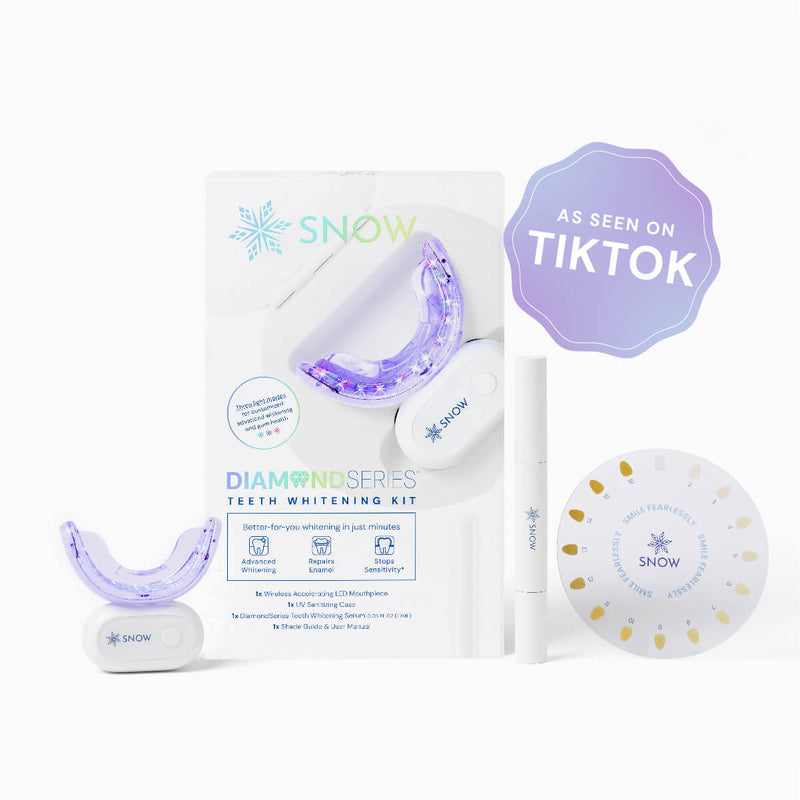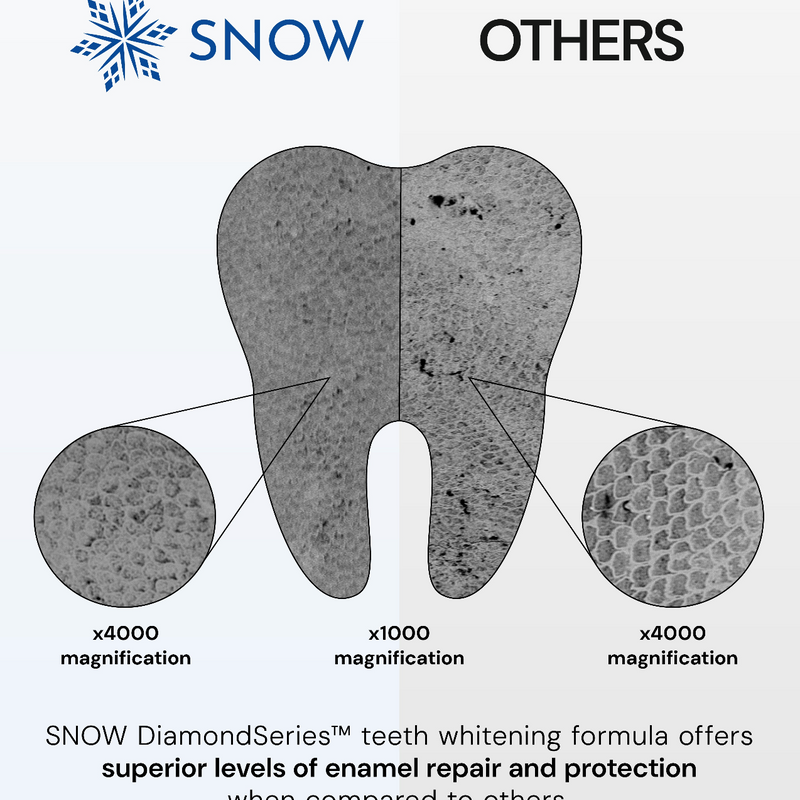Nothing beats the luster of a bright white smile. If you're wondering: how does teeth whitening work? You've come to the right place.
Flossing and brushing daily are habits that help keep your oral hygiene healthy. Having a healthy mouth helps you better prepare for professional or at-home teeth whitening treatments. Your dentist will recommend that your oral health is in good standing before you whiten your teeth. Tooth decay or cavities can cause whitening treatments to be painful.
Daily consumption of dark-tinted food and drinks and certain lifestyle habits can also impact teeth whiteness. Over time, residual particles of food, stains from drinking coffee, tooth sensitivity, and the natural aging process take a toll on your teeth.
Your teeth naturally lose their brightness over time. Many people with yellow teeth may feel embarrassed or self-conscious. If you survey what people most want to improve their smile, the majority vote for whiter teeth.
This article highlights how teeth whitening works and what you can do to get a whiter and brighter smile.
What causes teeth stains?
Teeth start turning yellow over time for several reasons. Here are a few listed below:
-
Tobacco. This substance contains two very harmful chemicals for the teeth: nicotine and tar. These two combine to form a surface-staining, yellowish substance when using tobacco. Where nicotine is naturally colorless until it combines with oxygen, the other chemical is black.
-
Certain foods and drinks. Red wine, tea, and coffee are the main perpetrators. They stain your teeth yellow because of chromogens, which are pigments. They stick to the outer, white part of your teeth.
-
Trauma. Any impact on your mouth, an accidental injury, can cause teeth yellowing. The former is a dark layer under your tooth's enamel. The tooth changes color when it lays down extra dentin due to an injury.
-
Aging. Age also causes the outer layer of the enamel to thin. Resulting in the yellowish dentin becoming more visible.
-
Medication. Teeth darkening may also happen due to certain medicines. These include high blood pressure, antipsychotics, and antihistamines medicines. Chemotherapy and neck and head radiation can also cause yellow teeth.
Hydrogen peroxide
Certain kinds of peroxides contain oxygen molecules. These peroxides include carbamide peroxide and hydrogen peroxide, facilitating the teeth whitening process.
When you expose your teeth' surface to these oxygen molecules, they cause an incredible reaction. The oxygen molecules proactively break the chemical bonds apart that hold the yellow stains onto your tooth enamel. This causes a teeth bleaching effect, thereby restoring the brightness and whiteness of your smile.
Is teeth whitening effective for everyone?
There are several types of teeth discoloration. What might work for you might not necessarily work for another person.
It is essential to consult your dentist to determine what kind of teeth discoloration you have. Not every whitening process works equally for all discoloration.
Teeth whitening products may also fail if your tooth discoloration is due to a tooth injury or medications.
Professional teeth whitening options
There are many products and treatments that effectively remove surface stains, from whitening gel to bleaching solutions and other professional whitening procedures.
One of the best approaches to whitening your teeth is to visit a dentist.
A professional can get your teeth whitened faster than a whitening gel in your at-home kits. A dentists' bleaching agent to whiten your teeth is more potent than home whitening kits.
Dentists use more concentrated solutions and methods in their teeth whitening processes for faster results. The downside is that they are usually more expensive.
The results will be around three to eight shades brighter. Many dentists also use advanced teeth whitening techniques that require only one appointment lasting two hours.
The zoom system, for instance, is one of the most popular processes, and its cost can vary between $500 to $1,000.
At-home teeth whitening options
Professional clinical teeth whitening works excellent, but at-home options can be just as effective and more affordable if you're on a budget.
Several at-home teeth whitening products include home whitening kits, whitening strips, and trays.
Whitening toothpaste
Every toothpaste is good for removing stains because they're mildly abrasive. However, whitening toothpaste is even more effective because it contains polishing and chemical agents.
A whitening toothpaste brightens the teeth more gradually and is effective. A robust whitening agent is suitable for scrubbing stains away and giving you brighter teeth. Another advantage of whitening toothpaste is that it's cost-friendly.
Several peroxide-containing kinds of toothpaste also have a gradual whitening effect.
Whitening trays
You can remove tooth stains at home by opting for tray-based systems. This whitening option features a whitening gel with a peroxide base.
The trays contain a bleaching solution to brighten your teeth when worn as directed.
You can get this system two ways: either have your dentist make custom-fit trays for you or purchase an over-the-counter system at your local drug store.
Whitening gels and strips
Whitening gel and strips are bleaching products with a peroxide base. You can apply these directly to your teeth. The results of this at-home option can last for four months or more.
How to keep your teeth white
Whether you have completed an at-home whitening process or a professional one, you'll want to keep your pearly whites bright.
Here are some tips to ensure your teeth remain white.
1. Avoid teeth-staining foods
It's essential to cut down on black tea, coffee, and red wine. Apart from these, avoid other dark-tinted foods such as marinara sauce, turmeric, and ketchup.
2. Use an electric toothbrush
There are distinct advantages between a manual and an electric toothbrush. Electric toothbrushes help lift extrinsic stains and minimize gum irritation.
Electric toothbrushes are more helpful in blasting away remaining food particles. Plus, electric toothbrushes have an oscillating, rotating, and vibrating pattern that breaks bacteria effectively.
3. Floss everyday
Flossing removes food particles stuck between your teeth. It helps pluck out debris that your toothbrush may have missed.
4. Use straws
It's a great practice to use straws for drinking beverages. Using a straw helps minimize direct teeth exposure to staining liquids.
If you can't cut down on your favorite beverages, you can use a straw to reduce tooth discoloration.
5. Routine dental visits
Visit your dentist regularly to ensure your teeth and gums are in optimal health. Getting your annual teeth cleanings and checkups helps prevent gingivitis, cavities, and tooth decay.
Is whitening toothpaste a good option?
Whitening toothpastes do remove stains from the surface of your teeth gradually.
However, they usually do not yield results as fast as other whitening methods.
To remove the stains from the surface of the teeth, a whitening toothpaste generally contains special abrasives, peroxides, and several chemicals. These help polish your teeth gently and dissolve and break down the stains.
If you opt to use whitening toothpaste, use it twice a day for six consecutive weeks to see a difference. It will help your teeth appear whiter.
Rinsing with water after having sweets and staining foods is always advised. When brushing with any toothpaste, it is important to spit out the excess but do not rinse your mouth. This allows the toothpaste to sit on the teeth longer and have its added benefits work longer.
Frequently Asked Questions
Why are professional teeth whitening treatments more effective?
Professional teeth whitening options are more effective because the bleaching chemicals come in a higher concentration. They have to be administered by a dental professional, and in comparison to a professional take-home whitening kit, the formula is more intense.
Is professional teeth whitening a safe option?
Yes, professional whitening processes are safe for the teeth and the gums.
How long do teeth-whitening trays take to show results?
You can expect to see results within two to four weeks after using whitening tray systems as directed.
Summary
You can either opt for an in-office whitening process or an at-home system for a brighter smile and whiter teeth. Teeth whitening agents contain a combination of mild abrasives, peroxides, and other chemicals that lighten teeth.
The professional whitening process in a dentist's clinic yields faster results. At-home options are generally milder and require consistent use for more extended periods for effective whitening results. Both options work great, it all depends on your personal preferences and goals.


























